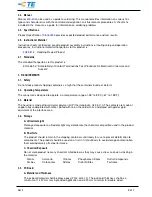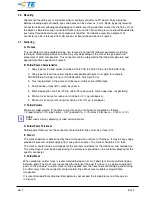
Rev 3
2
of 7
2.4.
Manual
can be used as a guide to soldering. This manual provides information on various flux
types and characteristics with the commercial designation an
d
flux removal procedures. A checklist is
included in the manual as a guide for information on soldering problems.
2.5.
Specifications
Product Specification
108-160303
provides expected product performance and test results.
2.6.
Instructional Material
Instruction sheets (408-series) provide product assembly instructions or tooling setup and operation
procedures. Instructional material that pertains to this product is:
2.7.
Standards
The standard that pertains to this product is:
EIA-364-
52, “Solderability of Contact Terminations Test Procedure for Electrical Connectors and
Sockets”
3.
REQUIREMENTS
3.1.
Safety
Do not stack product shipping containers so high that the containers buckle or deform.
3.2.
Operating Temperature
The connector is designed to operate in a temperature range of -55° to 85°C [-67° to 185°F].
3.3.
Material
The housing is made of liquid crystal polymer (LCP) thermoplastic, UL 94-V-0. The contacts are made of
copper alloy underplated with nickel, plated with tin on the solder tails, and plated with gold or gold
equivalent at the interface area.
3.4.
Storage
A.
Ultraviolet Light
Prolonged exposure to ultraviolet light may deteriorate the chemical composition used in the product
material.
B.
Shelf Life
The product should remain in the shipping containers until ready for use to prevent deformation to
components. The product should be used on a first in, first out basis to avoid storage contamination
that could adversely affect performance.
C.
Chemical Exposure
Do not store product near any chemical listed below as they may cause stress corrosion cracking in
the material.
Alkalis
Ammonia
Citrates
Phosphates Citrates
Sulfur Compounds
Amines
Carbonates
Nitrites
Sulfur Nitrites
Tartrates
3.5.
PC Board
A.
Material and Thickness
The pc board material shall be glass epoxy (FR-4 or G-10). The pc board thickness shall be a
minimum of 1.457 mm for single sided application and 2.20 mm minimum for double sided.

























